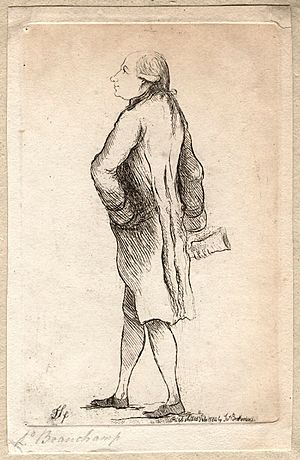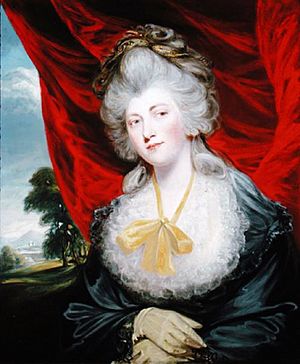Francis Ingram-Seymour-Conway, 2nd Marquess of Hertford facts for kids
Quick facts for kids
The Most Honourable
The Marquess of Hertford
|
|
|---|---|

Francis Seymour Conway, 2nd Marquess of Hertford, by James Sayers, engraving by James Bretherton
|
|
| Chief Secretary for Ireland | |
| In office 1765–1766 |
|
| Monarch | George III |
| Prime Minister | The Marquess of Rockingham |
| Preceded by | The Earl of Drogheda |
| Succeeded by | Augustus Hervey |
| Master of the Horse | |
| In office 1804–1806 |
|
| Monarch | George III |
| Prime Minister | William Pitt the Younger |
| Preceded by | The Earl of Chesterfield |
| Succeeded by | William Pitt the Younger |
| Lord Chamberlain of the Household | |
| In office 1812 – 14 December 1821 |
|
| Monarch | |
| Prime Minister | |
| Preceded by | The Earl of Dartmouth |
| Succeeded by | The Duke of Montrose |
| Personal details | |
| Born | 12 February 1743 London, England |
| Died | 17 June 1822 (aged 79) London, England |
| Political party | Tory |
| Spouses |
|
Francis Ingram-Seymour-Conway, 2nd Marquess of Hertford (born 12 February 1743 – died 17 June 1822) was an important British politician and nobleman. He was known by different titles throughout his life, including Viscount Beauchamp and Earl of Yarmouth. He served in both the Irish and British parliaments for many years. He also held significant roles in the Royal Household, like being the Lord Chamberlain.
Contents
Early Life and Education
Francis Ingram-Seymour-Conway was born in London on 12 February 1743. His family, the Seymour family, was very well-known. His father was Francis Seymour-Conway, 1st Marquess of Hertford. His mother was Lady Isabella Fitzroy. Francis had two younger brothers, Lord Robert Seymour and Lord Hugh Seymour. He went to school at Eton College and then studied at Christ Church, Oxford university.
His Political Journey
Francis Hertford started his political career in 1761. He became a member of the Irish House of Commons for Lisburn. Later, he represented County Antrim. In 1775, he joined the Privy Council of Ireland, which was a group of advisors to the monarch. From 1765 to 1766, he worked as the Chief Secretary for Ireland under his own father, who was the Lord Lieutenant of Ireland.
In 1766, he also became a Member of Parliament in the House of Commons of Great Britain. He first represented Lostwithiel and then Orford. He stayed in the British Parliament until 1794, when he took over his father's title.
Challenges in Lisburn
In 1783, Hertford faced some challenges from his tenants in Lisburn. They chose a different person, Todd Jones, to represent them in parliament. Jones wanted the Irish parliament to be more independent and reformed. By 1790, Hertford's chosen candidates won back control of the area. This happened after Jones argued that changes were not possible without allowing Catholics more rights.
Views on Irish Politics
Hertford himself supported giving more rights to Catholics. In 1778, he spoke strongly in favor of removing laws that were unfair to Roman Catholics. In 1782, he also supported the idea of Ireland having its own laws. However, he did not agree with all the calls for parliamentary reform, like changing who could vote. He also did not want Ireland to become too independent.
Roles in Government
Hertford held several important government jobs. He worked under Lord North as a Lord of the Treasury starting in 1774. From 1780, he was the Cofferer of the Household, a role that was later removed in 1782. In 1780, he also joined the Privy Council of the United Kingdom, advising the British monarch.
He was out of office for some time but returned in 1804. William Pitt the Younger made him Master of the Horse. He kept this job until Pitt's death in 1806. Later, from 1812 to 1821, he served as Lord Chamberlain of the Household under Prime Ministers Spencer Perceval and Lord Liverpool.
Other Important Roles
Besides his political work, Hertford was also the Lord Lieutenant of Warwickshire from 1816 to 1822. He was also the Governor of County Antrim. In 1807, he was given a special honor and became a Knight of the Garter.
Near the end of his life, he wanted to become a Duke, but Lord Liverpool did not agree. In 1829, he made sure that the Members of Parliament who supported him voted for the Roman Catholic Relief Act 1829. This important law finally allowed Protestants to no longer have a complete monopoly on Parliament.
Family Life
Lord Hertford married twice. His first wife was the Hon. Alice Elizabeth Windsor. They married on 4 February 1768. She passed away in 1772.
He then married the Hon. Isabella Anne Ingram on 20 May 1776. When Isabella's mother passed away in 1807, Francis and Isabella added the surname Ingram to their own. This was because they inherited a large fortune from her.
Lord Hertford passed away in London in June 1822, at the age of 79. His son from his second marriage, Francis, took over his title. The Marchioness of Hertford, Isabella, died in April 1834.



